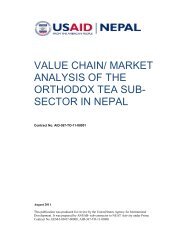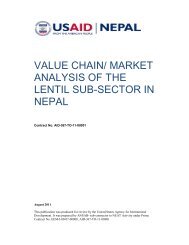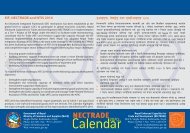value chain/ market analysis of the ginger sub-sector ... - Nepal Trade
value chain/ market analysis of the ginger sub-sector ... - Nepal Trade
value chain/ market analysis of the ginger sub-sector ... - Nepal Trade
- No tags were found...
You also want an ePaper? Increase the reach of your titles
YUMPU automatically turns print PDFs into web optimized ePapers that Google loves.
inging goods from Surkhet needs to pay DDC tax only in Surkhet <strong>of</strong> NPRs. 0.25 NPR/kgand are not charged in Banke.Farmers mostly transport <strong>the</strong>ir produce to local collectors or road-head traders. In someinstances, <strong>the</strong> local collectors go to farmers fields and procure <strong>the</strong> goods. In this case <strong>the</strong>transportation cost is borne by local traders. The price <strong>of</strong> <strong>ginger</strong> varies according to seasons.During <strong>the</strong> <strong>of</strong>fseason (May, June, July) <strong>the</strong> price is high and usually mo<strong>the</strong>r rhizomes aresold; whereas, during <strong>the</strong> main harvesting season (November, December, January) <strong>the</strong> priceis low. During this study, <strong>the</strong> calculated average price received by farmers was 25 NPR/kg.The gross margin received by farmers comes to be 6.92 NPR/kg. Road-head traders anddistrict traders bear <strong>the</strong> cost <strong>of</strong> <strong>market</strong>ing which is estimated to be 3.86 NPR/kg. Usually,road-head traders supply goods to district/national traders who sell mainly to exporters orsometimes to Indian commission agents directly. The gross margin calculated for <strong>market</strong>ingand processing actors are 5.35 NPR and 2.1 NPR per kg.2.4 World MarketGlobally, both <strong>the</strong> export and import <strong>value</strong> <strong>of</strong> <strong>ginger</strong> is growing every year which shows goodprospects for <strong>the</strong> <strong>ginger</strong> business.2.4.1 World ExportThe world export <strong>market</strong> <strong>of</strong> <strong>ginger</strong> is growing by 27.14 percent by <strong>value</strong> and 5.18 percent byvolume annually. In terms <strong>of</strong> <strong>value</strong>, major exporting countries <strong>of</strong> <strong>ginger</strong> are China, Nigeria,Ne<strong>the</strong>rlands, Thailand, and Ethiopia. In terms <strong>of</strong> volume; <strong>the</strong> major countries are China,Thailand, <strong>Nepal</strong>, Nigeria and Ne<strong>the</strong>rlands. <strong>Nepal</strong> lies in 8 th position in terms <strong>of</strong> total earningand in 3 rd position in terms <strong>of</strong> <strong>the</strong> total export volume <strong>of</strong> <strong>ginger</strong>. The Compound AnnualGrowth Rate (CAGR) in terms <strong>of</strong> <strong>value</strong> <strong>of</strong> <strong>Nepal</strong> is 19.75 percent which is below <strong>the</strong> worldaverage. The CAGR <strong>of</strong> <strong>Nepal</strong>ese <strong>ginger</strong> in terms <strong>of</strong> volume is 13.82 percent which showsthat <strong>the</strong> unit price <strong>of</strong> <strong>Nepal</strong>i <strong>ginger</strong> increased from 2009 to 2010 (See Annexes 2 & 3 fordetails).<strong>Trade</strong> indicators show that <strong>Nepal</strong> has exported 5.4 percent and 6.6 percent <strong>of</strong> <strong>the</strong> total worldexport in 2009 and 2010 respectively while receiving monetary benefits <strong>of</strong> 1.2 percent and1.4 percent respectively. In <strong>the</strong> period <strong>of</strong> 2006 to 2010, CAGRs <strong>of</strong> China in export <strong>value</strong> andvolume were 26.8 percent and 1.7 percent respectively and <strong>the</strong> CAGRs <strong>of</strong> India in export<strong>value</strong> and volume were 5.4 percent and -11.3 percent respectively. From <strong>the</strong>se figures, we canderive that <strong>Nepal</strong> is receiving fewer benefits from exports compared to <strong>the</strong> world andneighboring countries like China and India (see Annex 4 for details).Among major exporting countries, <strong>the</strong> unit price <strong>of</strong> <strong>Nepal</strong>ese <strong>ginger</strong> is <strong>the</strong> lowest. Germany,UK, Ethiopia, and Nigeria are achieving better prices in <strong>the</strong> world <strong>ginger</strong> <strong>market</strong>. Globally,China is <strong>the</strong> biggest exporter with a 67.1 percent share followed by Nigeria, Ne<strong>the</strong>rlands, andThailand. The unit price <strong>of</strong> Chinese <strong>ginger</strong> is significantly high compared to <strong>Nepal</strong>.The following table depicts <strong>the</strong> facts and figures on <strong>the</strong> export <strong>of</strong> <strong>ginger</strong> from China whichcan provide trade intelligence for <strong>Nepal</strong>i exporters.Value Chain/Market Analysis-Ginger 11






